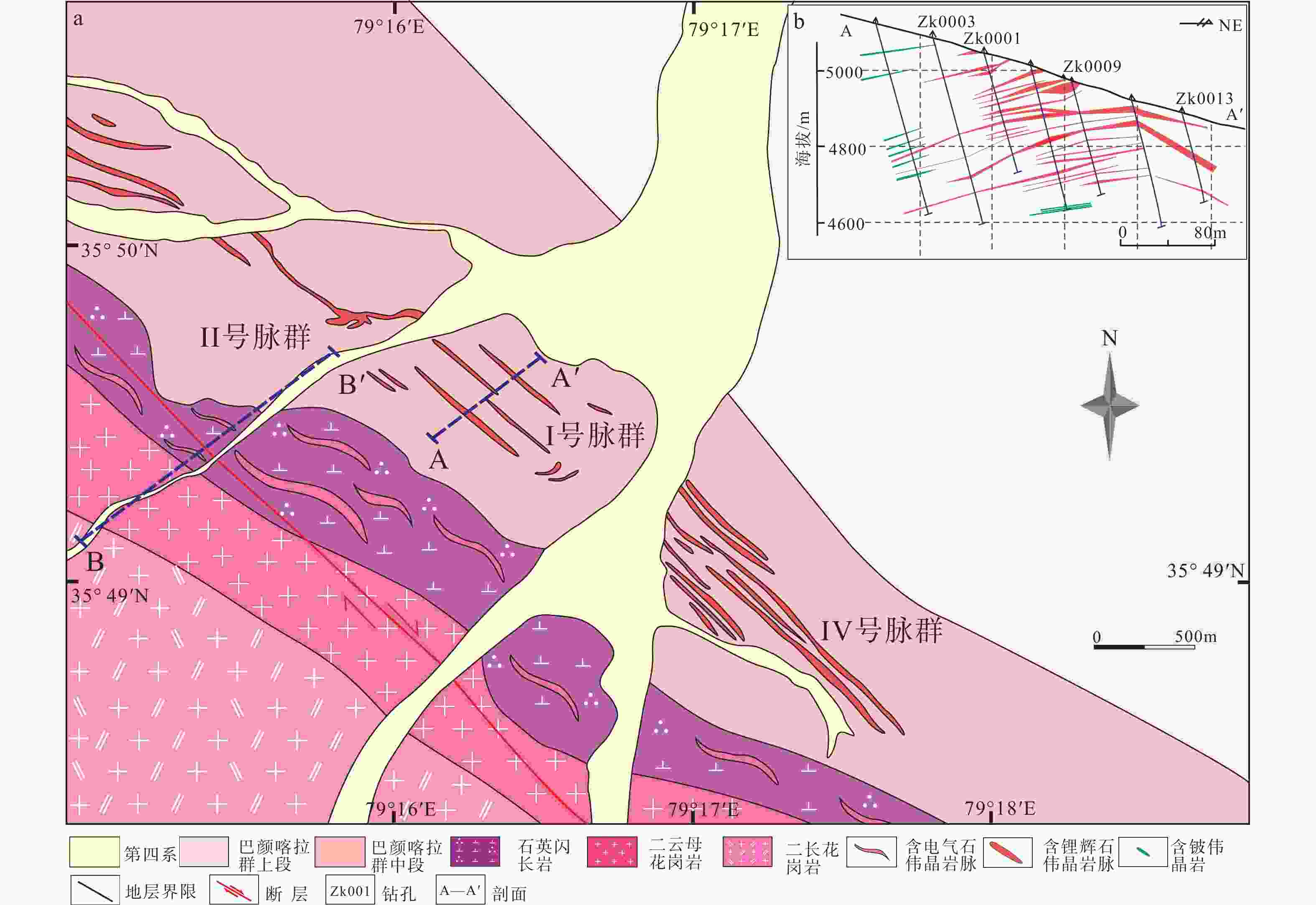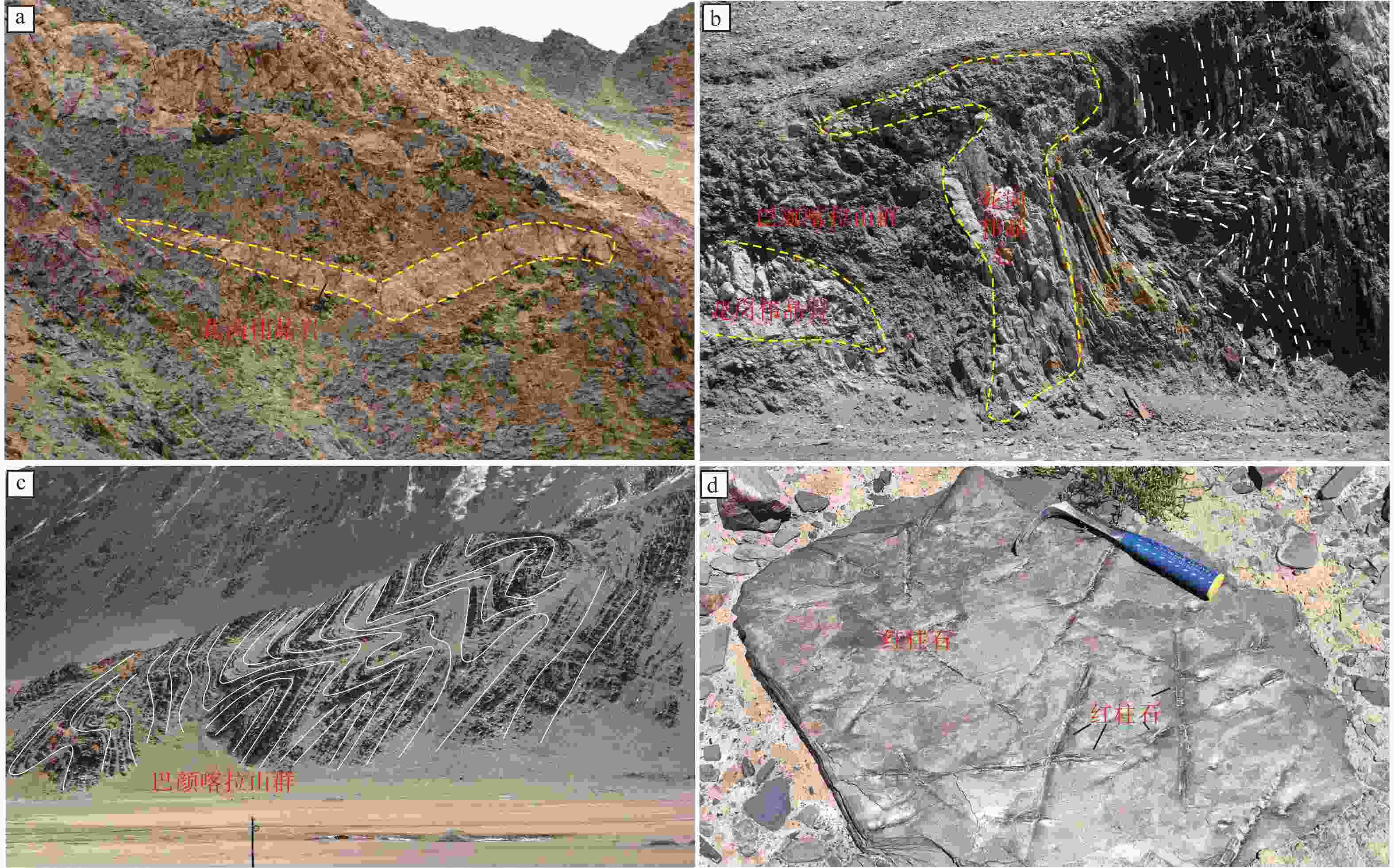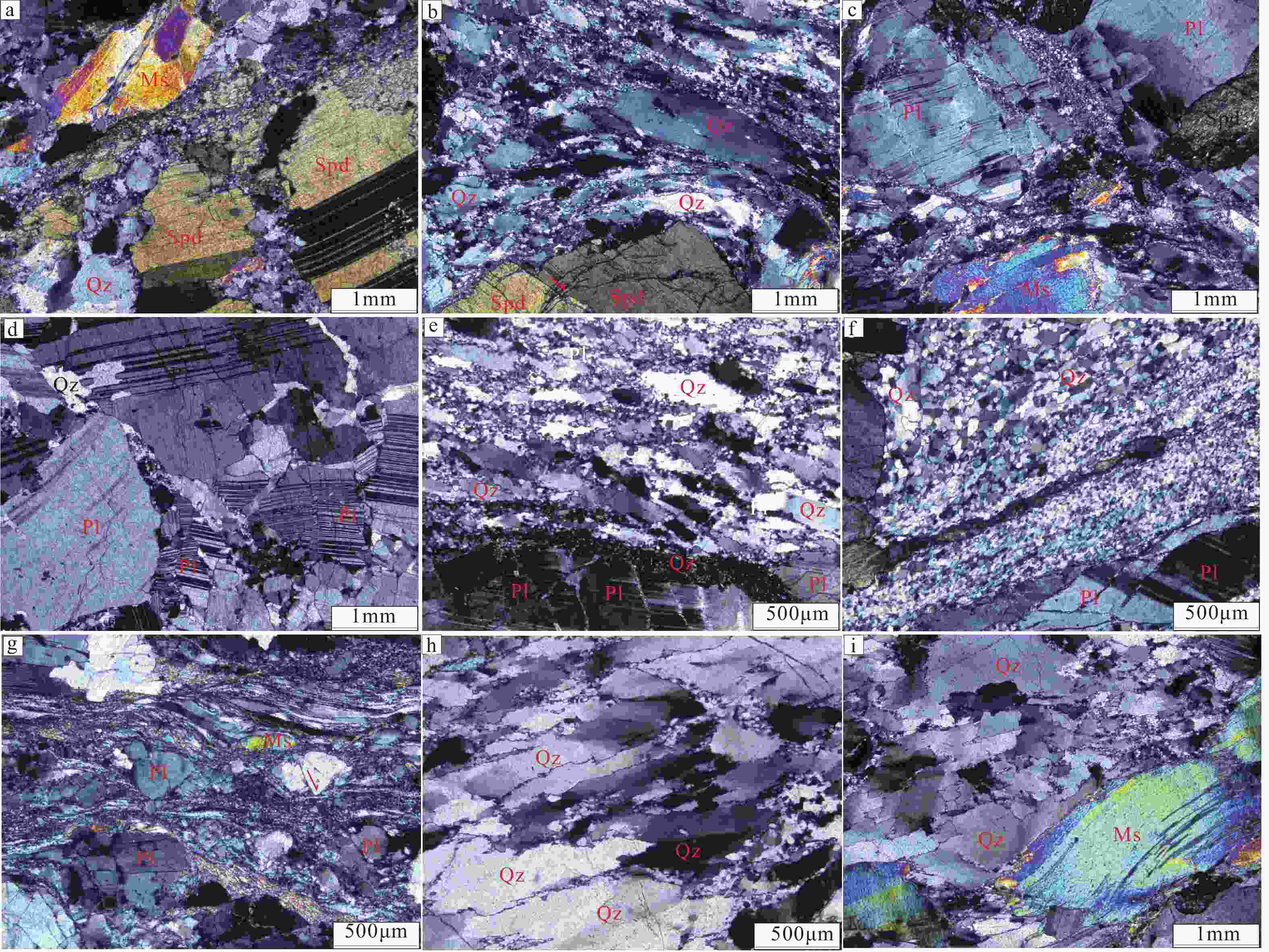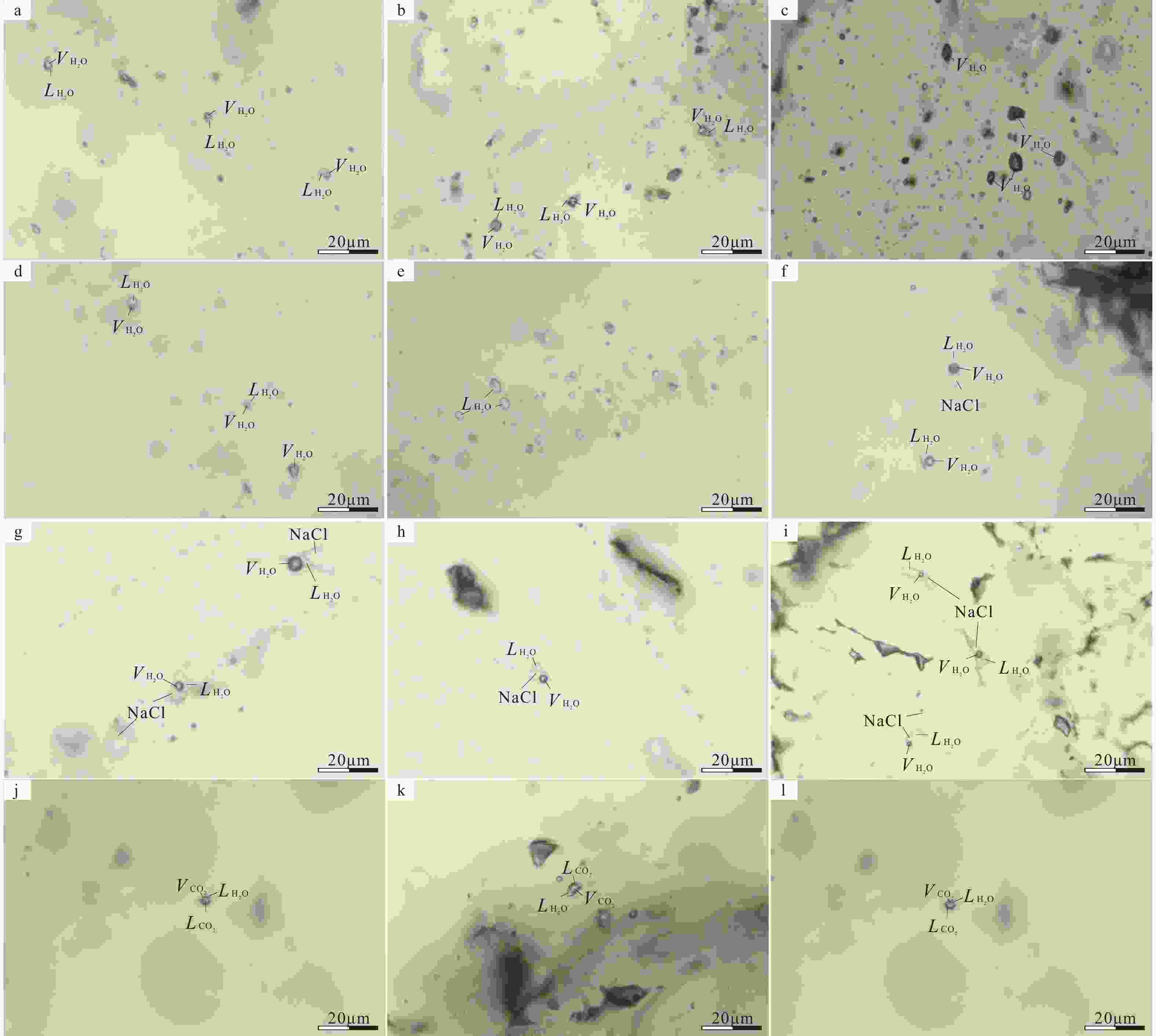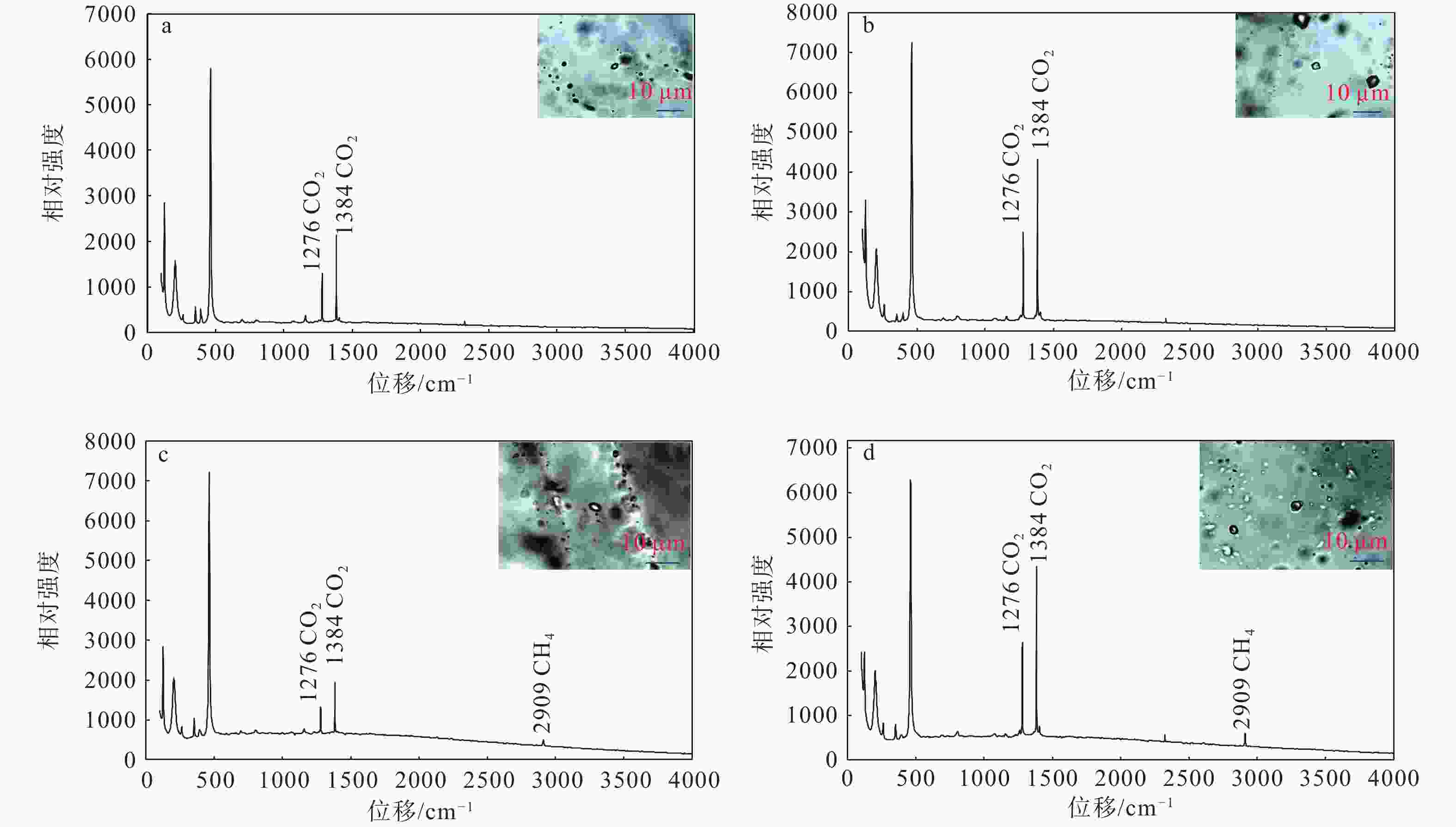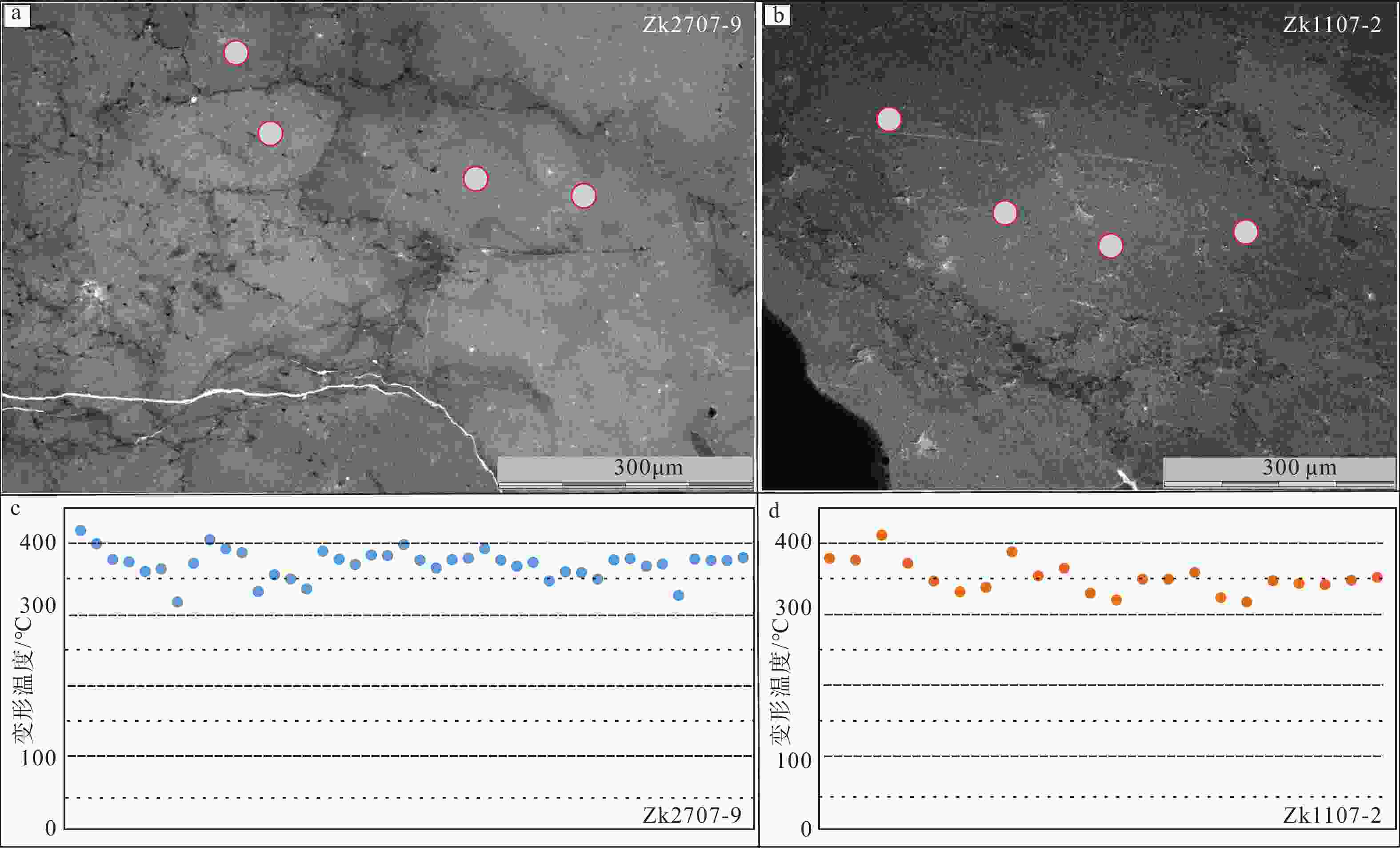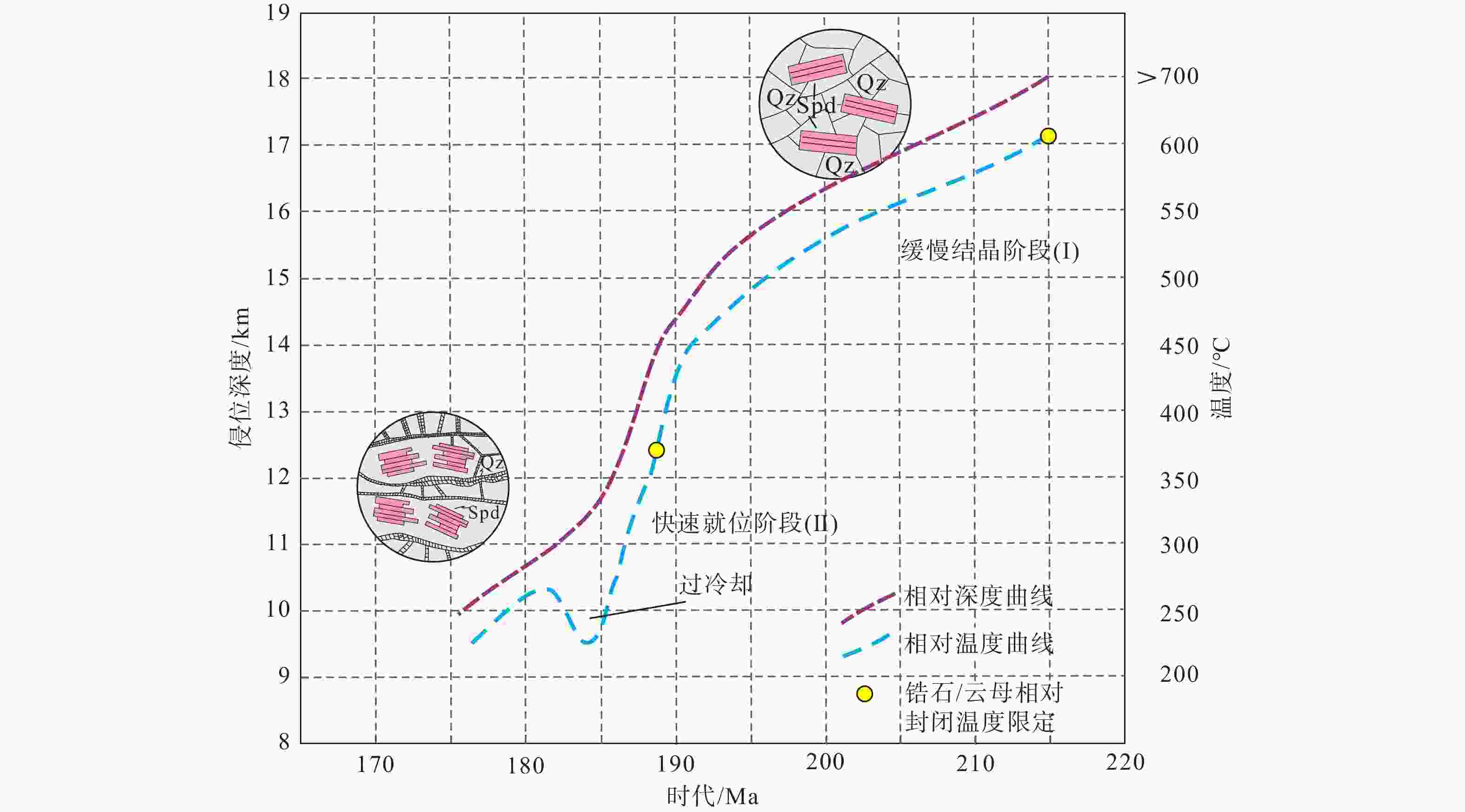Quartz deformation characteristics, deformation temperature, and their constraints on pegmatites of the 509 Daobanxi lithium deposit in the West Kunlun area, Xinjiang
-
摘要: 509道班西锂矿床是西昆仑造山带新近发现的大型伟晶岩型锂多金属矿床。作为区内典型的花岗伟晶岩型锂矿床,509道班西锂矿的成矿机制和伟晶岩演化过程对认识整个西昆仑成矿带的成矿作用具有重要意义。作为花岗伟晶岩中的重要矿物,石英是追踪伟晶岩成矿作用过程的理想对象。509道班西矿床的花岗伟晶岩普遍发育强烈的糜棱岩化作用,具有典型的韧性变形特征,通过对糜棱岩化伟晶岩脉进行变形组构分析、石英包裹体测温和石英Ti温度计计算,揭示了与伟晶岩就位相关的大陆地壳变形过程中流体的热力学演化过程,并探讨了韧性变形对区域找矿的启示意义。糜棱岩化伟晶岩中锂辉石、斜长石等矿物主要以脆性破裂为主,具有刚体变形的特征;石英主要发育膨凸重结晶现象,细小的新晶体在较大的石英条带边部形成,可见石英残斑,并具有亚颗粒旋转现象,部分发育核幔构造;白云母普遍变形成云母鱼。石英包裹体、锂辉石和石英的变形特征等微观结构证据表明,糜棱岩化伟晶岩的变形温度为300~400 ℃,石英Ti温度计得出的变形温度为371~398 ℃和351~377 ℃。伟晶岩中石英包裹体的均一温度平均为260~283 ℃,可能记录了石英变形晚阶段的温度。研究表明,509道班西地区的伟晶岩在侵位过程中经历了一期强烈的低温、高应变速率的韧性变形,伟晶岩就位是快速冷却过程的产物,在高应力和较低温度条件下,动态重结晶(GBM)导致的晶粒粒径减小严重改变了岩石的流变学性质;从~400 ℃到~260 ℃的超冷却过程(ΔT=±140 ℃)中,造成伟晶岩中矿物结晶新核迅速减少,更有利于形成粗大的石英等矿物颗粒,形成伟晶岩脉所有显著特征和独特的岩石结构和矿物组合的空间分带,超冷却在伟晶岩就位过程中具有重要的作用。Abstract:
Objective The 509 Daobanxi deposit in the West Kunlun orogenic belt is a newly discovered large pegmatite-type lithium-polymetallic deposit in northwestern China. As a typical granite pegmatite lithium deposit in the region, the metallogenic characteristics and pegmatite evolution of the 509 Daobanxi deposits are of great significance for understanding the entire lithium-polymetallic mineralization process of the West Kunlun metallogenic belt. The granite pegmatites contain assemblages of plagioclase, spodumene, quartz, muscovite, etc., exhibiting strong mylonization and forming typical ductile deformation characteristics in the 509 Daobanxi deposit. Quartz, an essential mineral in granite pegmatite, is ideal for tracking pegmatite's mineralization process and studying the deformation behavior of continental rocks in long-term geological history. Methods To study the late-stage emplacement process of pegmatite evolution, comprehensive analyses were conducted on the quartz deformation structures measurements, fluid inclusion temperature, and quartz trace elements for the 509 Daobanxi granite pegmatites. Cathodoluminescence (CL) analysis of quartz in deformed granite pegmatite samples was performed to reveal the compositional zoning of Ti in quartz. Laser ablation inductively coupled plasma mass spectrometry (LA-ICP-MS) was used to analyze 64 points from samples Zk2707-9 and Zk1107-2. Results The minerals of spodumene and plagioclase in deformed pegmatites primarily show brittle fracturing characteristics, with the features of rigid body deformation and the muscovite presence of mica-fish. Meanwhile, the conspicuous feature is that quartz grains mainly develop dynamic recrystallization and contain subgranis. According to the microstructural characteristics of spodumene, plagioclase, and quartz, the deformation temperature of mylonitized granite pegmatite is 300~400℃. The CL images of quartz bands in the granite pegmatite samples have no apparent zoning, indicating that the Ti content reaches a relative equilibrium state in the quartz deformation stage. The LA-ICP-MS analysis shows quartz from the 509 Daobanxi granite pegmatites contains a lower concentration of Ti (1.03 ×10−6 to 7.67×10−6 and 1.04 ×10−6 to 6.75×10−6), suggesting relatively lower deformation temperatures. The Ti-in-quartz thermobarometry indicates quartz deformation temperatures ranging from 371 to 398°C and 351 to 377°C, respectively. The thermometric measurement shows that homogenization temperatures of the quartz fluid inclusions in pegmatite varied from 260℃ to 283℃, likely recording the temperature of the late stage of pegmatite evolution. Conclusion Comprehensive analysis shows that the 509 Daobanxi granite pegmatites underwent a period of intense ductile deformation during the emplacement process, with low temperature and high strain rate. The emplacement of pegmatite is a product of the rapid cooling process, and the grain size reduction caused by dynamic recrystallization (GBM) under high-stress and low-temperature conditions profoundly changed the rheological properties of pegmatite. The supercooling process from ~400℃ to ~260℃ (ΔT=140℃±), resulting in less rapid mineral crystalline new nuclei in pegmatites, is more conducive to the formation of coarse quartz and other mineral particles, forming the significant characteristics of granite pegmatites. [ Significance ]In fact, the emplacement process of granitic pegmatites remains a puzzle, and high-quality, accurate systematic work is needed to understand the evolution process and behavior of granite pegmatite. By studying the 509 Daobanxi granite pegmatites, we proposed that the pegmatite emplacement was a product of the rapid cooling process, and supercooling plays an essential role in pegmatite emplacement. Similar deformation characteristics are widely developed in the Tugeman lithium deposit in the Altyn Tagh area and the Jiajika lithium deposit in the western Sichuan. Although the current work is preliminary, our study provides some clues for exploring the emplacement process of granitic pegmatites. -
Key words:
- mylonization /
- lithium ore /
- granite pegmatites /
- 509 Daobanxi area /
- West Kunlun /
- Xinjiang
-
图 1 大红柳滩地区大地位置与地质简图
a—西昆仑及邻区大地构造图(据Yin and Harrison,2000修改);b—大红柳滩地区地质图(据王核等,2017修改)
Figure 1. Geological map of the study area
(a) Tectonic map of West Kunlun and adjacent areas (modified after Yin and Harrison, 2000); (b) Geological map of Dahongliutan area (modified after Wang et al., 2017)
图 3 509道班西锂矿构造剖面与岩脉野外特征(剖面位置见图2)
a—剖面特征;b—花岗伟晶岩与石英闪长岩呈互层状产出;c、d—巴颜喀拉山群浅变质岩与花岗伟晶岩接触关系
Figure 3. Schetch and field photos showing the typical structural profile and field characteristics of the 509 Daobanxi lithium ore deposit (Profile location is shown in Fig.2.)
(a) Sketch of typical structural profile of the 509 Daobanxi area; (b) Photo of quartz diorite and intercalated granite pegmatites; (c and d) Photos showing the intrusive contact relation between meta-sedimentary rocks in Bayankalashan Group and granite pegmatites
图 4 509道班西锂矿花岗伟晶岩中的典型矿物特征
a—脉状伟晶岩;b—锂辉石巨晶;c—边部发育细晶花岗岩和电气石;d—过渡带发育长石、石英;e—核部发育石英颗粒;f—电气石布丁化
Figure 4. Photos showing typical mineral features in granite pegmatites of the 509 Daobanxi lithium deposit
(a) Veined pegmatites; (b) Spodumene megacrysts; (c) Fine-grained granite and oriented tourmaline in the edge zone; (d) Feldspar and quartz in the transition zone; (e)Pure quartz in a core zone; (f) Tourmaline boudinage
图 5 509道班西锂矿伟晶岩典型矿物分带特征和模式图
Pl—斜长石; Tur—电气石; Qz—石英; Brl—绿柱石; Grt—石榴子石; Ms—白云母a—矿物分带野外特征;b—矿物分带模式图
Figure 5. Typical mineral zoning features and pattern diagram of the pegmatite dike in the 509 Daobanxi lithium deposit, West Kunlun (a) Field characteristics of mineral zoning; (b) Mineral zoning pattern diagram
Pl–plagioclase;Tur–tourmaline; Qz–quartz; Brl–beryl; Grt–garnet; Ms–muscovite
图 6 509道班西巴颜喀拉山群地层及变形特征
a—巴颜喀拉山群中发育树杈状花岗伟晶岩; b—巴颜喀拉山群中发育似层状伟晶岩; c—巴颜喀拉山群褶皱变形;d—接触带发育红柱石等矿物
Figure 6. The deformation characteristics of the Bayankalashan Group in the 509 Daobanxi area
(a) Dendritic granitic pegmatite in the Bayankalashan group; (b) Stratified pegmatite in the Bayankalashan group; (c) Folding deformation characteristics of the Bayankalashan Group; (d) Minerals such as andalusite developed along the contact zone of the granites and the Bayankalashan Group
图 7 509道班西锂矿伟晶岩矿物变形特征
Spd—锂辉石;Pl—斜长石;Qz—石英;Ms—白云母a、b—变形伟晶岩中锂辉石发育脆性破裂,石英发育膨凸重结晶;c—g—斜长石等发育破裂,石英发育膨凸重结晶;h、i—石英颗粒发育亚颗粒旋转现象,并发育“核幔构造”,发育云母鱼
Figure 7. Deformation characteristics of nimerals in pegmatites of the 509 Daobanxi lithium deposit
(a and b) Brittle fracture of spodumene, and expansion and bulging recrystallization of quartz in deformed pegmatite zone; (c–g) Brittle fracture of feldspar, and expansion and bulging recrystallization of quartz in deformed pegmatite zone; (h and i) Muscovite fish, and subgranular rotation developed in quartz grains, exhibiting “nuclear–mantle structure” Spd–spodumene; Pl–plagioclase; Qz–quartz; Ms–muscovite
图 8 509道班西花岗伟晶岩中石英流体包裹体显微照片
$V_{{\rm{CO}}_2} $—气相CO2;$L_{{\rm{CO}}_2} $—液相CO2;$L_{{\rm{H}}_2{\rm{O}}} $—液相H2O;$V_{{\rm{H}}_2{\rm{O}}} $—气相H2O;NaCl—NaCl子矿物a、b—气液两相包裹体;c—富气相包裹体群;d—气液包裹体与富气相包裹体共存;e—富液相包裹体群;f—气液两相包裹体和含子矿物的三相包裹体;g、h—含子矿物的三相包裹体;i—发育在裂隙中的含子矿物的三相包裹体;j—l—含CO2包裹体
Figure 8. Microphotos showing characteristics of quartz inclusion in pegmatites of the 509 Daobanxi lithium deposit
(a and b) Gas–liquid two-phase inclusions; (c) Gas-rich phase inclusion group; (d) Coexistence of gas–liquid inclusions and gas-rich inclusions; (e) Liquid-rich phase inclusion group; (f) Gas-liquid two-phase inclusions and three-phase inclusions containing daughter minerals; (g and h)Three-phase inclusions containing daughter minerals; (i) Three-phase inclusions containing daughter minerals developed in fractures; (j–l) CO2-bearing inclusions $V_{{\rm{CO}}_2} $–gas phase CO2; $L_{{\rm{CO}}_2} $–liquid phase CO2; $L_{{\rm{H}}_2{\rm{O}}} $–liquid phase H2O; $V_{{\rm{H}}_2{\rm{O}}} $–gas phase H2O; NaCl–NaCl daughter minerals
图 11 不同构造层次典型矿物的变形特征和流体超冷却与晶体成核程度图
a—不同构造层次典型矿物的变形特征(Fossen and Cavalcante,2017);b—流体超冷却与晶体成核程度图(London and Morgan,2012)
Figure 11. Diagrams illustrating the typical mineral deformation characteristics at different tectonic levels and the crystal-nucleation delay and the onset of undercooling time (a) Typical mineral deformation characteristics at different tectonic levels (Fosson and Cavalcante, 2017); (b) The crystal-nucleation delay and the onset of undercooling time (London and Morgan, 2012)
图 12 西昆仑地区509道班西花岗伟晶岩就位示意图
Spd—锂辉石;Qz—石英;深度与温度曲线是结合此次研究和王威等(2022)的年代学研究限定的
Figure 12. Diagram showing the emplacement of granite pegmatites in the 509 Daobanxi deposit, West Kunlun Spd–spodumene; Qz–quartz; The depth and temperature curves are constrained by the results of this study and the chronology research by Wang et al. (2022).
表 1 509道班西锂矿伟晶岩中石英包裹体测温数据
Table 1. Temperature data of quartz fluid inclusions in pegmatites of the 509 Daobanxi lithium deposit
赋存矿物 样品数量 包裹体类型 均一温度/℃ 冰点/℃ CO2络合物融化温度/℃ 盐度 石英 36 Ⅱ 232~310(273) −3.3~−11(−6.6) — 6.3~14.95(9.5) 石英 30 Ⅲ 210~303(260) −3.6~−9.1(−6.36) 5.9~8.9(7.3) 2.23~4.64(5.25) 石英 4 Ⅳ 244~310(283) −5.5~−9.7(−7.4) — 7.6~12.5(9.7) 注:()内为平均值 表 2 509道班西锂矿伟晶岩中石英的变形温度
Table 2. Deformation temperature of quartz in pegmatites of the 509 Daobanxi lithium deposit
样品号 测点 Ti/×10−6 P/kbar T/℃
(aTiO2=1)T/℃
(aTiO2=0.8)T/℃
(aTiO2=0.6)测点 Ti/×10−6 P/kbar T/℃
(aTiO2=1)T/℃
(aTiO2=0.8)T/℃
(aTiO2=0.6)Zk2707-9 A1 7.67 3.7 418 431 449 A24 3.60 3.7 376 388 404 A2 5.54 3.7 399 412 429 A25 2.90 3.7 365 376 392 A3 3.67 3.7 377 389 405 A26 3.64 3.7 377 388 404 A4 3.44 3.7 374 385 401 A27 3.80 3.7 379 391 407 A5 2.63 3.7 360 371 386 A28 4.87 3.7 392 404 421 A6 2.82 3.7 364 375 390 A29 3.61 3.7 376 388 404 A7 1.03 3.7 317 327 340 A30 3.05 3.7 368 379 394 A8 3.31 3.7 372 383 399 A31 3.39 3.7 373 385 400 A9 6.11 3.7 405 418 435 A33 1.99 3.7 347 357 372 A11 4.88 3.7 392 405 421 A34 2.62 3.7 360 371 386 A12 4.40 3.7 387 399 415 A35 2.55 3.7 359 370 385 A13 1.45 3.7 332 342 356 A36 2.10 3.7 349 360 375 A14 2.38 3.7 355 366 381 A37 3.61 3.7 376 388 404 A16 2.11 3.7 349 360 375 A38 3.75 3.7 378 390 406 A17 1.56 3.7 335 346 360 A39 3.04 3.7 367 379 394 A18 4.56 3.7 389 401 417 A40 3.24 3.7 371 382 398 A19 3.70 3.7 377 389 405 A41 1.28 3.7 326 336 350 A20 3.20 3.7 370 382 397 A42 3.71 3.7 378 389 405 A21 4.13 3.7 383 395 412 A43 3.59 3.7 376 388 403 A22 4.08 3.7 383 395 411 A44 3.57 3.7 376 387 403 A23 5.41 3.7 398 410 427 A45 3.85 3.7 380 391 408 Zk1107-2 A46 3.74 3.7 378 390 406 A57 1.11 3.7 320 330 343 A47 3.57 3.7 376 387 403 A58 2.08 3.7 349 360 374 A48 6.75 3.7 410 423 441 A59 2.08 3.7 349 360 374 A49 3.28 3.7 371 383 399 A60 2.54 3.7 358 370 385 A50 1.97 3.7 346 357 371 A70 1.20 3.7 323 333 347 A51 1.43 3.7 331 341 355 A71 1.04 3.7 317 327 340 A52 1.64 3.7 337 348 362 A72 2.00 3.7 347 358 372 A53 4.45 3.7 387 399 416 A75 1.84 3.7 343 354 368 A54 2.31 3.7 354 365 379 A76 1.78 3.7 341 352 366 A55 2.86 3.7 364 376 391 A77 2.02 3.7 347 358 373 A56 1.37 3.7 329 340 353 A78 2.21 3.7 351 362 377 -
[1] BREITER K, ĎURIŠOVÁ J, DOSBABA M, 2020. Chemical signature of quartz from S- and A-type rare-metal granites-A summary[J]. Ore Geology Reviews, 125: 103674. doi: 10.1016/j.oregeorev.2020.103674 [2] BRISBIN W C, 1986. Mechanics of pegmatite intrusion[J]. American Mineralogist, 71(3-4): 644-651. [3] CHEN M, WANG H, ZHANG X Y, et al. , 2022. Judgment of metallogenic potential of Kangxiwa pegmatite in Xinjiang: evidence from zircon U-Pb geochronology, geochemistry and Lu-Hf isotope[J]. Acta Petrologica Sinica, 38(7): 2095-2112. (in Chinese with English abstract) doi: 10.18654/1000-0569/2022.07.17 [4] FAN J J, TANG G J, WEI G J, et al. , 2020. Lithium isotope fractionation during fluid exsolution: implications for Li mineralization of the Bailongshan pegmatites in the west Kunlun, NW Tibet[J]. Lithos, 352-353: 105236. doi: 10.1016/j.lithos.2019.105236 [5] FOSSEN H, CAVALCANTE G C G, 2017. Shear zones-a review[J]. Earth-Science Reviews, 171: 434-455. doi: 10.1016/j.earscirev.2017.05.002 [6] HONG T, ZHAI M G, WANG Y J, et al. , 2023. Coupling relationship between the stability of Li/Be complexes and Li/Be differential enrichment in granitic pegmatites—an experimental study[J]. Earth Science Frontiers, 30(5): 93-105. (in Chinese with English abstract) [7] KEYSER W, MÜLLER A, KNOLL T, et al. , 2023. Quartz chemistry of lithium pegmatites and its petrogenetic and economic implications: examples from Wolfsberg (Austria) and Moylisha (Ireland)[J]. Chemical Geology, 630: 121507. doi: 10.1016/j.chemgeo.2023.121507 [8] KOHN M J, NORTHRUP C J, 2009. Taking mylonites’ temperatures[J]. Geology, 37(1): 47-50. doi: 10.1130/G25081A.1 [9] LARSEN R B, POLVÉ M, JUVE G, 2000. Granite pegmatite quartz from Evje-Iveland: trace element chemistry and implications for the formation of high-purity quartz[J]. Norges Geologiske Undersøgelse Bulletin, 436: 57-65. [10] LI J K, LI P, CHEN Z Y, 2023. Metallogenic regularity, prediction and assessment of strategic metal mineral resources such as lithium and beryllium: preface[J]. Acta Petrologica Sinica, 39(7): 1881-1886. (in Chinese with English abstract) doi: 10.18654/1000-0569/2023.07.01 [11] LI Y, WANG W, DU X F, et al. , 2022. 40Ar/39Ar dating of muscovite of the west 509 Daoban Li-Be rare metal deposit in the west Kunlun orogenic belt and its limitation to regional mineralization[J]. Geology in China, 49(6): 2031-2033. (in Chinese with English abstract) [12] LONDON D, KONTAK D J, 2012. Granitic pegmatites: scientific wonders and economic bonanzas[J]. Elements, 8(4): 257-261. doi: 10.2113/gselements.8.4.257 [13] LONDON D, MORGAN VI G B, 2012. The pegmatite puzzle[J]. Elements, 8(4): 263-268. doi: 10.2113/gselements.8.4.263 [14] LONDON D, 2018. Ore-forming processes within granitic pegmatites[J]. Ore Geology Reviews, 101: 349-383. doi: 10.1016/j.oregeorev.2018.04.020 [15] MÜLLER A, IHLEN P M, SNOOK B, et al. , 2015. The chemistry of quartz in granitic pegmatites of southern Norway: petrogenetic and economic implications[J]. Economic Geology, 110(7): 1737-1757. doi: 10.2113/econgeo.110.7.1737 [16] MÜLLER A, KEYSER W, SIMMONS W B, et al. , 2021. Quartz chemistry of granitic pegmatites: implications for classification, genesis and exploration[J]. Chemical Geology, 584: 120507. doi: 10.1016/j.chemgeo.2021.120507 [17] PASSCHIER C W, TROUW R A J, 2005. Microtectonics[M]. 2nd ed. Berlin: Springer: 31-60. [18] PLATT J P, BEHR W M, 2011. Grainsize evolution in ductile shear zones: implications for strain localization and the strength of the lithosphere[J]. Journal of Structural Geology, 33(4): 537-550. doi: 10.1016/j.jsg.2011.01.018 [19] ROTTIER B, CASANOVA V, 2021. Trace element composition of quartz from porphyry systems: a tracer of the mineralizing fluid evolution[J]. Mineralium Deposita, 56(5): 843-862. doi: 10.1007/s00126-020-01009-0 [20] RUBIN A M, 1995. Getting granite dikes out of the source region[J]. Journal of Geophysical Research: Solid Earth, 100(B4): 5911-5929. doi: 10.1029/94JB02942 [21] TAN K B, GUO Q M, GUO Y M, 2021. U-Pb age of granite from Li-beryllium polymetallic deposit and its tectonic significance in 509 Daobanxi of Hotan, Xinjiang[J]. Nonferrous Metals of Xinjiang, 44(2): 6-10. (in Chinese) [22] TANG J L, KE Q, XU X W, et al. , 2022. Magma evolution and mineralization of Longmenshan lithium-beryllium pegmatite in Dahongliutan area, west Kunlun[J]. Acta Petrologica Sinica, 38(3): 655-675. (in Chinese with English abstract) doi: 10.18654/1000-0569/2022.03.05 [23] TANG W C, DUAN W, ZOU L, et al. , 2022. A method for locating ore bodies by geochemical indexes of pegmatite-type lithium deposits in the Ke'eryin area, western Sichuan, China [J]. Journal of Geomechanics, 28(5): 765−792 (in Chinese with English abstract). [24] THOMAS J B, WATSON E B, SPEAR F S, et al. , 2010. TitaniQ under pressure: the effect of pressure and temperature on the solubility of Ti in quartz[J]. Contributions to Mineralogy and Petrology, 160(5): 743-759. doi: 10.1007/s00410-010-0505-3 [25] WANG D H, DAI H Z, LIU S B, et al. , 2022. New progress and trend in ten aspects of lithium exploration practice and theoretical research in China in the past decade[J]. Journal of Geomechanics, 28(5): 743-764. (in Chinese with English abstract) [26] WANG H, LI P, MA H D, et al. , 2017. Discovery of the Bailongshan superlarge lithium-rubidium deposit in Karakorum, Hetian, Xinjiang, and its prospecting implication[J]. Geotectonica et Metallogenia, 41(6): 1053-1062. (in Chinese with English abstract) [27] WANG H, GAO H, ZHANG X Y, et al. , 2020. Geology and geochronology of the super-large Bailongshan Li–Rb–(Be) rare-metal pegmatite deposit, west Kunlun orogenic belt, NW China[J]. Lithos, 360-361: 105449. doi: 10.1016/j.lithos.2020.105449 [28] WANG H, XU Y G, YAN Q H, et al. , 2021. Research progress on Bailongshan pegmatite type lithium deposit, Xinjiang[J]. Acta Geologica Sinica, 95(10): 3085-3098. (in Chinese with English abstract) [29] WANG H, HUANG L, MA H D, et al. , 2023. Geological characteristics and metallogenic regularity of lithium deposits in Dahongliutan-Bailongshan area, west Kunlun, China[J]. Acta Petrologica Sinica, 39(7): 1931-1949. (in Chinese with English abstract) doi: 10.18654/1000-0569/2023.07.04 [30] WANG W, DU X F, LIU W, et al. , 2022. Geological characteristic and discussion on metallogenic age of the west 509-Daoban Li-Be rare metal deposit in the west Kunlun orogenic belt[J]. Acta Petrologica Sinica, 38(7): 1967-1980. (in Chinese with English abstract) doi: 10.18654/1000-0569/2022.07.10 [31] WARK D A, WATSON E B, 2006. TitaniQ: a titanium-in-quartz geothermometer[J]. Contributions to Mineralogy and Petrology, 152(6): 743-754. doi: 10.1007/s00410-006-0132-1 [32] WEI X P, WANG H, ZHANG X Y, et al. , 2018. Petrogenesis of Triassic high-Mg diorites in western Kunlun orogen and its tectonic implication[J]. Geochimica, 47(4): 363-379. (in Chinese with English abstract) [33] XU Y G, WANG R C, WANG C Y, et al. , 2021. Highly fractionated granites and rare-metal mineralization[J]. Lithos, 398-399: 106262. doi: 10.1016/j.lithos.2021.106262 [34] XU Z Q, ZHU W B, ZHENG B H, et al. , 2023. New ore-controlling theory of “multilayered domal granitic sheets” of the Jiajika pegmatite-type lithium deposit: the major discoveries of the “Jiajika pegmatite-type lithium deposit scientific drilling project (JSD)”[J]. Acta Geologica Sinica, 97(10): 3133-3146. (in Chinese with English abstract) [35] YAN Q H, QIU Z W, WANG H, et al. , 2018. Age of the Dahongliutan rare metal pegmatite deposit, west Kunlun, Xinjiang (NW China): constraints from LA-ICP-MS U-Pb dating of columbite-(Fe) and cassiterite[J]. Ore Geology Reviews, 100: 561-573. doi: 10.1016/j.oregeorev.2016.11.010 [36] YAN Q H, WANG H, CHI G X, et al. , 2022. Recognition of a 600-km-long Late Triassic rare metal (Li-Rb-Be-Nb-Ta) pegmatite belt in the western Kunlun orogenic belt, Western China[J]. Economic Geology, 117(1): 213-236. doi: 10.5382/econgeo.4858 [37] YIN A, HARRISON T M, 2000. Geologic evolution of the Himalayan-Tibetan orogen[J]. Annual Review of Earth and Planetary Sciences, 28: 211-280. doi: 10.1146/annurev.earth.28.1.211 [38] ZHANG X Y, WANG H, YAN Q H, 2022. Garnet geochemical compositions of the Bailongshan lithium polymetallic deposit in Xinjiang Province: implications for magmatic-hydrothermal evolution[J]. Ore Geology Reviews, 150: 105178. doi: 10.1016/j.oregeorev.2022.105178 [39] ZHANG Z Y, JIANG Y H, NIU H C, et al. , 2021. Fluid inclusion and stable isotope constraints on the source and evolution of ore-forming fluids in the Bailongshan pegmatitic Li-Rb deposit, Xinjiang, western China[J]. Lithos, 380-381: 105824. doi: 10.1016/j.lithos.2020.105824 [40] ZHENG F B, WANG G G, NI P, 2021. Research progress on the fluid metallogenic mechanism of granitic pegmatite-type rare metal deposits[J]. Journal of Geomechanics, 27(4): 596-613. (in Chinese with English abstract) [41] ZHOU Q F, QIN K Z, ZHU L Q, et al. , 2023. Overview of magmatic differentiation and anatexis: insights into pegmatite genesis[J]. Earth Science Frontiers, 30(5): 26-39. (in Chinese with English abstract) [42] ZHOU J S, WANG Q, XU Y G, et al. , 2021. Geochronology, petrology, and lithium isotope geochemistry of the Bailongshan granite-pegmatite system, northern Tibet: Implications for the ore-forming potential of pegmatites, Chemical Geology, 584: 120484. [43] 陈谋, 王核, 张晓宇, 等, 2022. 新疆康西瓦伟晶岩的成矿潜力判断: 来自锆石U-Pb年代学、地球化学与Hf同位素证据[J]. 岩石学报, 38(7): 2095-2112. doi: 10.18654/1000-0569/2022.07.17 [44] 洪涛, 翟明国, 王岳军, 等, 2023. 锂铍络合物稳定性与花岗伟晶岩中锂铍“差异跃迁”耦合关联[J]. 地学前缘, 30(5): 93-105. [45] 李建康, 李鹏, 陈振宇, 2023. 锂铍等战略性金属矿产资源成矿规律与预测评价: 前言[J]. 岩石学报, 39(7): 1881-1886. [46] 李永, 王威, 杜晓飞, 等, 2022. 西昆仑509道班西锂铍稀有金属矿白云母40Ar/39Ar定年及对区域成矿的限定[J]. 中国地质, 49(6): 2031-2033. [47] 谭克彬, 郭岐明, 郭勇明, 2021. 新疆和田509道班西锂铍多金属矿床花岗岩U-Pb年龄及其构造意义[J]. 新疆有色金属, 44(2): 6-10. [48] 唐俊林, 柯强, 徐兴旺, 等, 2022. 西昆仑大红柳滩地区龙门山锂铍伟晶岩区岩浆演化与成矿作用[J]. 岩石学报, 38(3): 655-675. [49] 唐文春, 段威, 邹林, 等, 2022. 川西可尔因地区伟晶岩型锂矿地球化学指标定位矿体的方法 [J]. 地质力学学报, 28(5): 765−792. [50] 王登红, 代鸿章, 刘善宝, 等, 2022. 中国锂矿十年来勘查实践和理论研究的十个方面新进展新趋势[J]. 地质力学学报, 28(5): 743-764. [51] 王核, 李沛, 马华东, 等, 2017. 新疆和田县白龙山超大型伟晶岩型锂铷多金属矿床的发现及其意义[J]. 大地构造与成矿学, 41(6): 1053-1062. [52] 王核, 徐义刚, 闫庆贺, 等, 2021. 新疆白龙山伟晶岩型锂矿床研究进展[J]. 地质学报, 95(10): 3085-3098. [53] 王核, 黄亮, 马华东, 等, 2023. 西昆仑大红柳滩—白龙山矿集区锂矿成矿特征与成矿规律初探[J]. 岩石学报, 39(7): 1931-1949. [54] 王威, 杜晓飞, 刘伟, 等, 2022. 西昆仑509道班西锂铍稀有金属矿地质特征与成矿时代探讨[J]. 岩石学报, 38(7): 1967-1980. [55] 魏小鹏, 王核, 张晓宇, 等, 2018. 西昆仑东部晚三叠世高镁闪长岩的成因及其地质意义[J]. 地球化学, 47(4): 363-379. [56] 许志琴, 朱文斌, 郑碧海, 等, 2023. 川西甲基卡伟晶岩型锂矿的“多层次穹状花岗岩席”控矿新理论: 记“川西甲基卡锂矿科学钻探”创新成果[J]. 地质学报, 97(10): 3133-3146. [57] 郑范博, 王国光, 倪培, 2021. 花岗伟晶岩型稀有金属矿床流体成矿机制研究进展[J]. 地质力学学报, 27(4): 596-613. [58] 周起凤, 秦克章, 朱丽群, 等, 2023. 花岗伟晶岩成因探讨: 岩浆分异与深熔[J]. 地学前缘, 30(5): 26-39. -




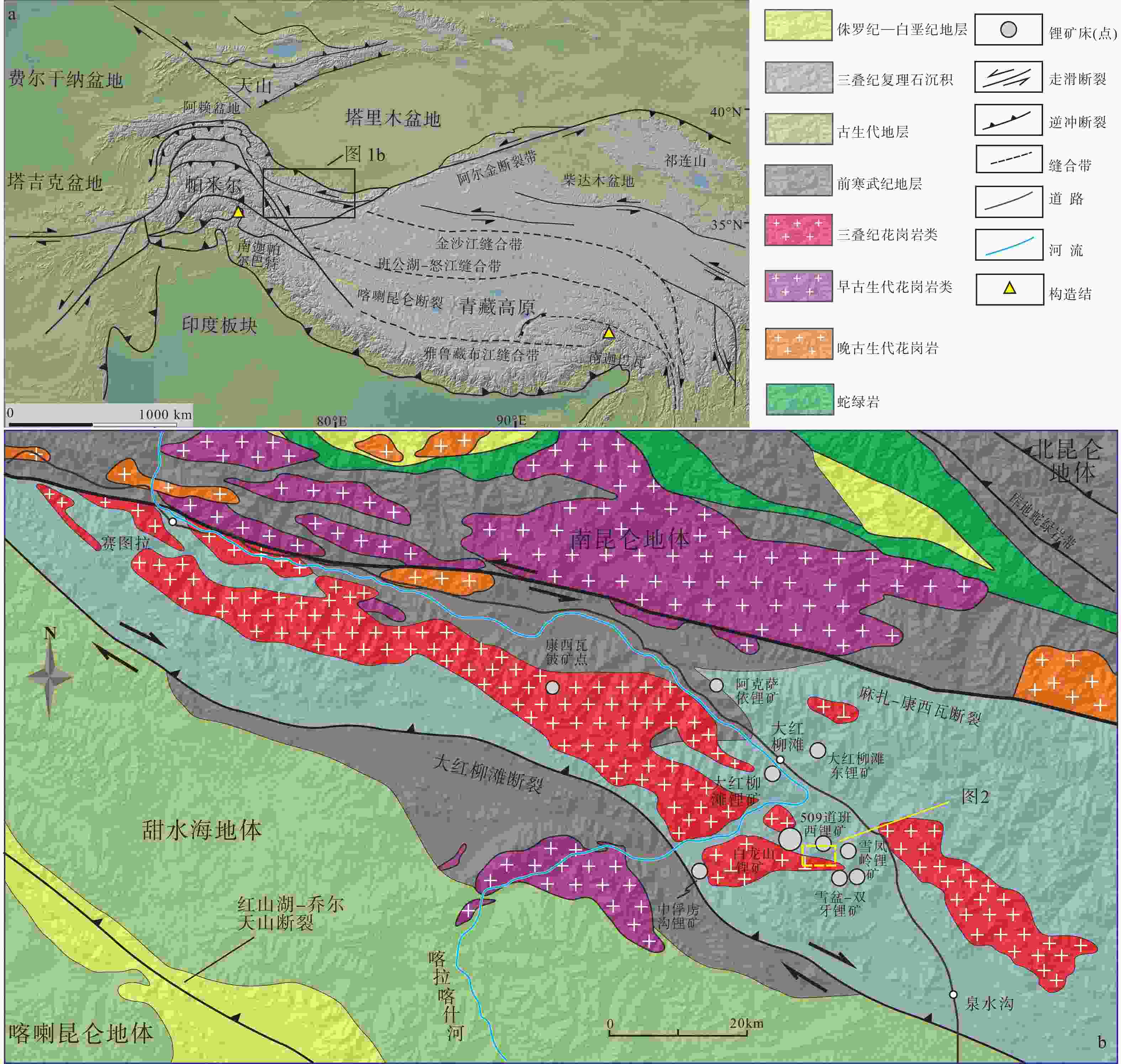
 下载:
下载:
